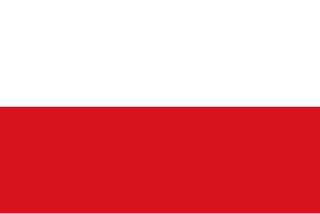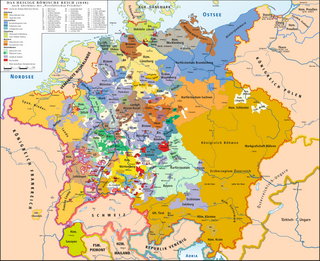
Rudolf II was Holy Roman Emperor (1576–1612), King of Hungary and Croatia, King of Bohemia (1575–1608/1611) and Archduke of Austria (1576–1608). He was a member of the House of Habsburg.

The Thirty Years' War was one of the longest and most destructive conflicts in European history, lasting from 1618 to 1648. Fought primarily in Central Europe, an estimated 4.5 to 8 million soldiers and civilians died as a result of battle, famine, and disease, while some areas of modern Germany experienced population declines of over 50%. Related conflicts include the Eighty Years' War, the War of the Mantuan Succession, the Franco-Spanish War, the Torstenson War, the Dutch-Portuguese War and the Portuguese Restoration War.

The Defenestrations of Prague were three incidents in the history of Bohemia in which people were defenestrated. Though already existing in Middle French, the word defenestrate is believed to have first been used in English in reference to the episodes in Prague in 1618 when the disgruntled Protestant estates threw two royal governors and their secretary out of a window of the Hradčany Castle and wrote an extensive apologia explaining their action. In the Middle Ages and early modern times, defenestration was not uncommon—the act carried elements of lynching and mob violence in the form of murder committed together.

The history of the Czech lands – an area roughly corresponding to the present-day Czech Republic – starts approximately 800,000 years BCE. A simple chopper from that age was discovered at the Red Hill archeological site in Brno. Many different primitive cultures left their traces throughout the Stone Age, which lasted approximately until 2000 BCE. The most widely known culture present in the Czech lands during the pre-historical era is the Únětice Culture, leaving traces for about five centuries from the end of the Stone Age to the start of the Bronze Age. Celts – who came during the 5th century BCE – are the first people known by name. One of the Celtic tribes were the Boii (plural), who gave the Czech lands their first name Boiohaemum – Latin for the Land of Boii. Before the beginning of the Common Era the Celts were mostly pushed out by Germanic tribes. The most notable of those tribes were the Marcomanni and traces of their wars with the Roman Empire were left in south Moravia.

The Battle of Nördlingen took place on 6 September 1634 during the Thirty Years' War. A combined Imperial-Spanish force inflicted a crushing defeat on the Swedish-German army.

Matthias was Holy Roman Emperor from 1612 to 1619, Archduke of Austria from 1608 to 1619, King of Hungary and Croatia from 1608 to 1618 and King of Bohemia from 1611 to 1617. His personal motto was Concordia lumine maior.

Ferdinand II was Holy Roman Emperor, King of Bohemia, Hungary, and Croatia from 1619 until his death in 1637. He was the son of Archduke Charles II of Inner Austria and Maria of Bavaria, who were devout Catholics. In 1590, when Ferdinand was 11 years old, they sent him to study at the Jesuits' college in Ingolstadt because they wanted to isolate him from the Lutheran nobles. A few months later, his father died, and he inherited Inner Austria–Styria, Carinthia, Carniola and smaller provinces. His cousin, the childless Rudolf II, Holy Roman Emperor, who was the head of the Habsburg family, appointed regents to administer these lands.

The Battle of White Mountain was an important battle in the early stages of the Thirty Years' War. It led to the defeat of the Bohemian Revolt and ensured Habsburg control for the next three hundred years.

Frederick V was the Elector Palatine of the Rhine in the Holy Roman Empire from 1610 to 1623, and reigned as King of Bohemia from 1619 to 1620. He was forced to abdicate both roles, and the brevity of his reign in Bohemia earned him the derisive sobriquet "the Winter King".

Albrecht Wenzel Eusebius von Wallenstein, also von Waldstein, was a Bohemian military leader and statesman who fought on the Catholic side during the Thirty Years' War (1618–1648). His successful martial career made him one of the richest and most influential men in the Holy Roman Empire by the time of his death. Wallenstein became the supreme commander of the armies of the Imperial Army of Holy Roman Emperor Ferdinand II and was a major figure of the Thirty Years' War.

The Catholic League was a coalition of Catholic states of the Holy Roman Empire formed 10 July 1609. While initially formed as a confederation to act politically to negotiate issues vis-à-vis the Protestant Union, modelled on the more intransigent ultra-Catholic French Catholic League (1576), it was subsequently concluded as a military alliance "for the defence of the Catholic religion and peace within the Empire".

The Protestant Union, also known as the Evangelical Union, Union of Auhausen, German Union or the Protestant Action Party, was a coalition of Protestant German states. It was formed on 14 May 1608 by Frederick IV, Elector Palatine in order to defend the rights, land and safety of each member. It included both Calvinist and Lutheran states, and dissolved in 1621.

Although the Kingdom of Bohemia, both of the Lusatias, the Margraviate of Moravia, and Silesia were all under Habsburg rule, they followed different paths of development. Moravians and Silesians had accepted the hereditary right of the Austrian Habsburgs to rule and thus escaped the intense struggle between native estates and the Habsburg monarchy that was to characterize Bohemian history. In contrast, the Bohemian Kingdom had entrenched estates that were ready to defend what they considered their rights and liberties. The Habsburgs pursued a policy of centralization and conflict arose, which was further complicated by ethnic and religious issues.

Vilém Slavata z Chlumu a Košumberka was a Czech nobleman from an old Bohemian family. As viceregent (místodržící) of Emperor Ferdinand II of Habsburg he became famous as co-victim, along with Jaroslav Borzita of Martinice, of the 1618 Defenestration of Prague.

The Battle of Jankau, also known as Jankov, Jankow, or Jankowitz, took place in central Bohemia, on 6 March 1645. One of the last major battles of the 1618 to 1648 Thirty Years' War, it was fought between Swedish and Imperial armies, each containing around 16,000 men. The more mobile and better led Swedes under Lennart Torstensson effectively destroyed their opponents, commanded by Melchior von Hatzfeldt. However, the devastation caused by decades of conflict meant armies now spent much of their time obtaining supplies, and the Swedes were unable to take advantage.
This article covers the period from the origin of the Moravian Church, as well as the related Hussite Church and Unity of the Brethren, in the early fourteenth century to the beginning of mission work in 1732. Further expanding the article, attention will also be paid to the early Moravian settlement at Bethlehem, Pennsylvania, following their first arrival in Nazareth, Pennsylvania in 1740.

Count Jindřich Matyáš of Thurn-Valsassina, was one of the leaders of the Protestant Bohemian Revolt against Emperor Ferdinand II. He took part in events that led to the Thirty Years' War, and after the war he became a military leader and diplomat in Swedish service, who eventually resided in Swedish Estonia.

The Bohemian Revolt was an uprising of the Bohemian estates against the rule of the Habsburg dynasty that began the Thirty Years' War. It was caused by both religious and power disputes. The estates were almost entirely Protestant, mostly Utraquist Hussite but there was also a substantial German population that endorsed Lutheranism. The dispute culminated after several battles in the final Battle of White Mountain, where the estates suffered a decisive defeat. This started re-Catholisation of the Czech lands, but also expanded the scope of the Thirty Years' War by drawing Denmark and Sweden into it. The conflict spread to the rest of Europe and devastated vast areas of Central Europe, including the Czech lands, which were particularly stricken by its violent atrocities.

Johann Georg [John George] von Brandenburg was a German nobleman and Protestant ecclesiastic in the Holy Roman Empire. He was the administrator (bishop) of Strasbourg from 1592 until 1604 and the Duke of Jägerndorf (Krnov), one of the Silesian duchies, from 1607 until 1624.
The imperial election of 1619 was an imperial election held to select the emperor of the Holy Roman Empire. It took place in Frankfurt on August 28.


















